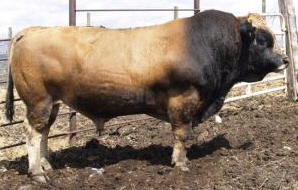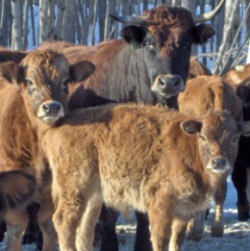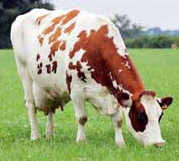



Aubrac
History
The Aubrac (also known as Laguiole) originates from the Auvergne in Southern France, specifically a small town called Aubrac. The first cattle registered in the genealogic records of the breed go back to 1894. A reading of the records reveals that the selection for what would become the Aubrac breed began much earlier than that year. In writings from the 17th Century, it is mentioned that the monks in the Benedictine order, living in the monastery of the town of Aubrac (in Auvergne), had already taken the first steps toward selecting specific traits in their cattle.

Photo courtesy of Alabama Aubracs, www.alabama-aubracs.com |
The Auvergne is mountainous and rough, not suited to grain production and so traits that were selected for were: hardiness, milking ability and productive grass fed cattle.
After the Revolution and the Napoleon Era had concluded and after a necessary period of recovery and calm, the true work of improving livestock was continued. In 1840 the Agricultural Society of Auvergne was founded, later replaced when the Herd Book for the Aubrac breed was created in 1893.
Throughout the 20th Century, advances in technology have made selection methods very efficient and have clearly improved the quality of the breed.
Today there is a strong emphasis on traits such as cows that calve on a regular basis (i.e.one calf per cow per year), longevity, increase in muscle growth and flexibility for grass fed and corn fed systems.
Characteristics
The colour of an Aubrac coat is fawn with varying shades, it can vary from wheat colour to pale grey. The coat is darker on the shoulders and on the croup. These characteristics are mostly noticeable on non castrated males, where the front end is almost black.
The tuft at the end of the tail, the cleats, nose, the tips of the horns, and the rims of the ears and eyes are black.
The horns are slightly twisted pointing backwards, although some are now polled.
The Aubrac is of moderate frame, well muscled and of a sturdy robust build with short strong legs made for mountainous regions.
The weight of an average adult bull is 900 to 1200 kgs and an average cow - 550 to 800 kgs, calves at birth weigh between 35 to 40 kgs.
This breed can feed well on rough forage such as grass, hay and finish well. The maternal qualities of fertility, calving ease and milk quantity are highly prised.
Statistics
Comparative
Interval between births (IVV)
Some average statistics:
IVV average: 382 days (average taken for 37,116 cows)
IVV cows in second birth: 394 days (for 34,705 cows)
IVV cows with more than two births: 375 days ( for 30,207 cows)
(Source: qualin files 2007-2)www.race-aubrac.com
Distribution

Photo courtesy of Fox Creek Ranch, www.fcraubrac.com |
For more than 10 years the breed has been exporting its genes in the form of semen (1,110 doses in 2000), of reproducers (160 registered in 2000) and of embryos, to more than 15 countries:
Germany, Ireland, Switzerland, Russia, Lithuania, Hungary, Austria, Great Britain, Spain, Luxembourg, Portugal, Canada, the United States, Morocco, Italy, Belgium, New Zealand, Israel etc.
References (the above information was cited from the following sites)
www.race-aubrac.com


